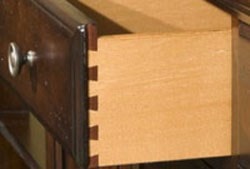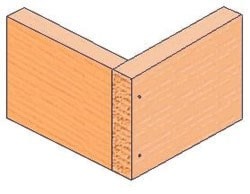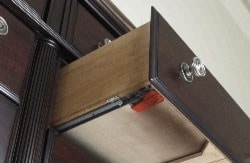
Drawer Construction Guide
by Nick, Digital Specialist | February 26, 2020
The quality of a dresser, chest-of-drawers, nightstand, or china cabinet can often depend on the construction of the dresser. What should you look for? Check this handy guide- complete with images!
Just by looking at two bedroom dressers side-by-side, you may not be able to tell the difference. They might look almost identical, but there could be a dramatic difference in price between them. There are a lot of things that affect the quality (and the price) of a dresser, but one of the biggest factors is the quality of its drawers. The best way to tell the quality of the drawer is to take it out of the dresser. Look for a catch or a trigger wherever you see the glides (more on that later), but don’t break anything. If you need help, ask someone at the store to help you. Then, use this article to guide you through what you’re looking at.
(By the way, this article applies to anything with a drawer- bedroom dressers and chests, nightstands, coffee and end tables, office furniture, china cabinets, buffets, and more!)
HOW IS IT BUILT? One of the most important things to look at is how the actual box of the drawer is put together. This has a huge impact on the weight it can hold and the overall durability of the drawer.

Dovetail: The oldest and sturdiest way to join two pieces of wood. It is easily identified by the interlocking pattern along the edges of the drawer. When done well, it doesn’t require any extra fasteners, but sometimes it’s glued for extra protection over time. Look for the dovetailing on the front and back of the drawer for the highest quality.

Mortise and tenon: Simply put, this involves a protruding piece (the tenon) being slid into a corresponding groove or hole on the other piece (the mortise) and secured into place with an adhesive. Another tried-and-true method that rivals the dovetail in terms of strength. This is one of the most common methods for building a drawer.

Butt joint: This is the simplest (and least durable) method for assembling a drawer. Basically, the two pieces of wood are placed flush at a 90-degree angle, then joined with adhesives and fasteners. Style is sacrificed as well, since the end grain of one of the pieces will always be visible.
WHERE ARE THE GLIDES LOCATED? This is personal preference more than anything else, but it’s helpful to know where they are so you’re not surprised when you get the piece home.

Center-mounted: You’ll find these on the bottom of the drawer. This doesn’t hold as much weight as side-mounted glides but keeps the glide out of sight for a cleaner look. These glides reduce the depth of the drawer but allow for a greater width. Occasionally, there are issues with the drawer being balanced correctly on the track.

Side-mounted: A more common approach, side-mounted glides tend to hold more weight but will sacrifice some width of the drawer. These glides will also be visible when the drawer is opened, perhaps taking away from the overall look of the piece.
WHAT ARE THE GLIDES MADE OUT OF?

Wood-on-wood: With a solid-wood or handcrafted piece, some manufacturers may prefer this style to maintain the style and integrity of the furniture. However, because it’s wood, it’s more susceptible to warping and cracking from temperature changes.

Metal-on-metal: Designed to carry more weight, these ensure a smooth operation and won’t be prone to warping from temperature change. It may be a pain to take these out of the dresser, though. Also, check the sturdiness of the metal- some lighter metals may be prone to bending.

Ball bearing: These are usually made of steel, and can hold upwards of 100 pounds. If you’re the kind of person who over-fills their drawers, this may be a feature to look for. You’ll get the smoothest action and the best durability with this kind of glide.
A FEW OTHER THINGS TO LOOK FOR

Corner blocking: Flip the drawer over to see if there are triangle-shaped blocks in the corner. If there are, the drawer is corner-blocked, which reinforces the bottom part of the drawer (the part that’s most likely to sag).

Soft-close: This feature may be called a few different things, but they are usually bottom-mounted metal glides that close the drawer on its own. It usually just needs a soft tap to shut completely, and the drawer won’t slam or rebound.

Felt lining: In a bedroom piece, this can protect delicate items of clothing from getting snagged on exposed wood. In a dining room piece, the felt can protect valuable items like silverware from getting scratched.

Dust proofing: This is usually a thin piece of wood between each drawer to prevent dust and other things from falling into the next drawer. This also is helpful when that pair of socks falls out the back of the drawer.

Cedar lining: These are usually found in the bottom drawer of a dresser or chest-of-drawers. Cedar naturally removes moisture from the air, so it will act as a dehumidifier and keep your clothes from developing mildew. Plus it smells nice!
As you can see, there are a ton of different ways to assemble a drawer. Knowing your own habits and needs will help you determine what kind is best for you and your family.

BROWSE BY TAG:
ALL CATEGORIES:
MOST POPULAR:
MOST RECENT:





